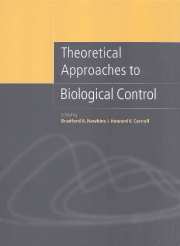Book contents
- Frontmatter
- Contents
- List of contributors
- Preface
- Part I Biological control theory: past and present
- 1 The theoretical foundations of biological control
- 2 Recent developments in theory for biological control of insect pests by parasitoids
- 3 Models in biological control: a field guide
- Part II Ecological considerations
- Part III Spatial considerations
- Part IV Genetic/evolutionary considerations
- Part V Microbes and pathogens
- Index
1 - The theoretical foundations of biological control
from Part I - Biological control theory: past and present
Published online by Cambridge University Press: 13 August 2009
- Frontmatter
- Contents
- List of contributors
- Preface
- Part I Biological control theory: past and present
- 1 The theoretical foundations of biological control
- 2 Recent developments in theory for biological control of insect pests by parasitoids
- 3 Models in biological control: a field guide
- Part II Ecological considerations
- Part III Spatial considerations
- Part IV Genetic/evolutionary considerations
- Part V Microbes and pathogens
- Index
Summary
Introduction
‘Theory without practice is fantasy, practice without theory is chaos’ (abridged from a forgotton author).
In this chapter I outline the fundamental theoretical concepts that I believe must underlie the practice of biological control, for without a theoretical foundation it is unlikely that we will succeed in any practical endeavor: it would be like trying to put a man on the moon without knowledge of the theories of gravity and planetary motion (Berryman, 1991). The question is, what is the theoretical foundation upon which the practice of biological control should rest?
In the context of this chapter, the term biological control is used to describe the control or regulation of pest populations at inocuous densities by their natural enemies. Hence, the theory of biological control contains elements of (i) control theory, which is concerned with the regulation of dynamic variables at, or near, set points or equilibria by negative feedback mechanisms, and (ii) predator–prey theory, which is concerned with the dynamics of interactions between predators and their prey.
Control theory
‘Negative feedback is the necessary technique by which long-term stability in complex systems can be obtained’
(Milsum, 1966).Control theory was originally developed by engineers for the purpose of regulating the dynamics of mechanical systems. However, the ideas of control theory are also part of the more general theories of dynamic systems and non-linear dynamics (or chaos theory).
- Type
- Chapter
- Information
- Theoretical Approaches to Biological Control , pp. 3 - 21Publisher: Cambridge University PressPrint publication year: 1999
- 30
- Cited by



